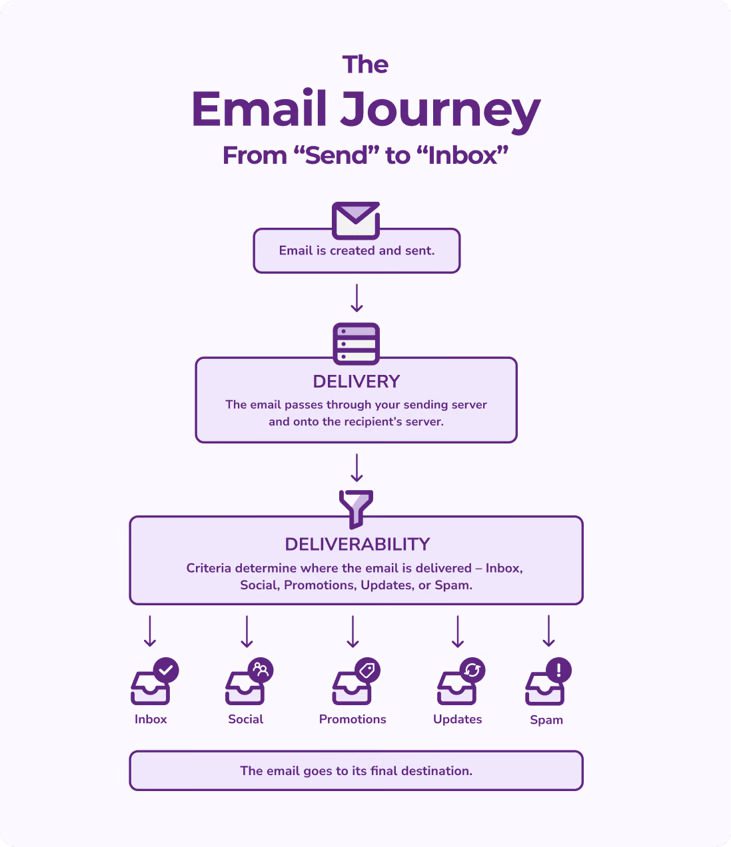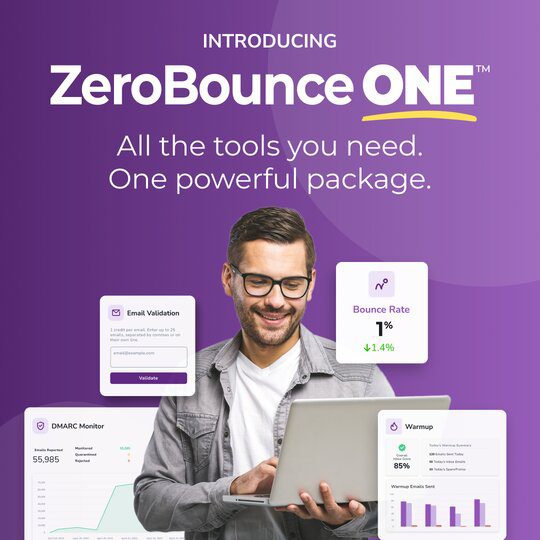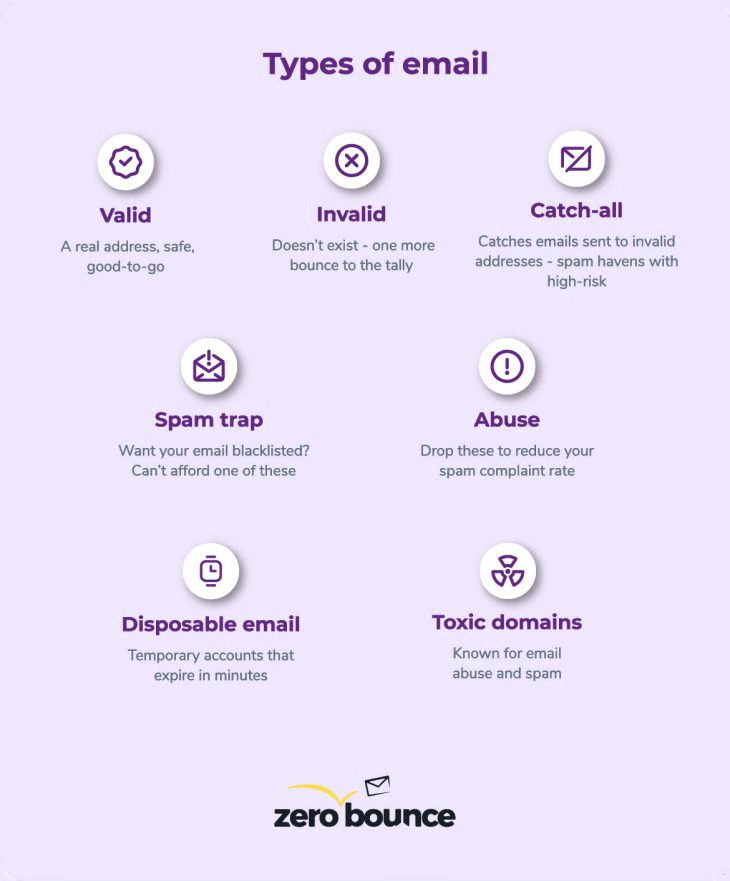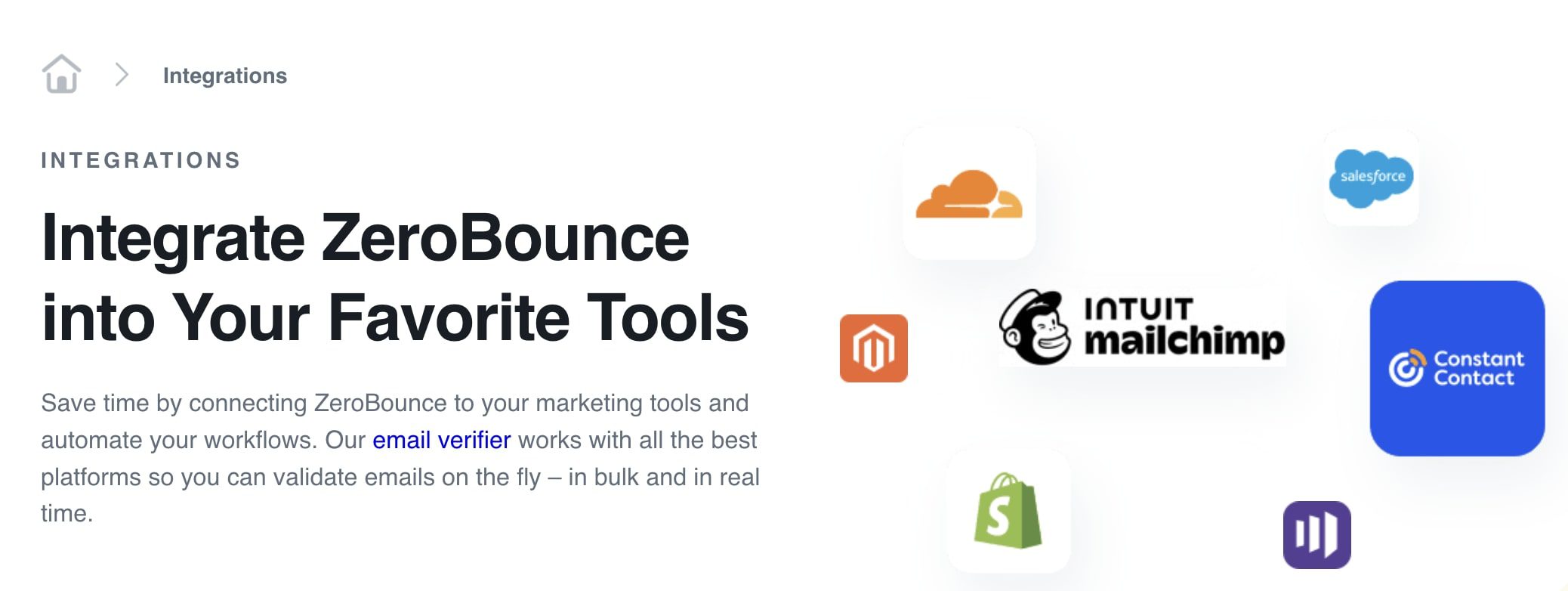
What Is Email Validation? A Simple Guide to Protecting Your Sender Reputation
Quick Answer
What’s the simplest way to keep your emails from ending up in the spam folder?
Short answer: Use email validation to verify every email address before you hit send. A reputable email validation tool catches typos, fakes, and dead inboxes so you only send emails to real people. Never add a contact to your list without validating it.
Why it matters: If you don’t validate your email list, you’ll inevitably end up sending emails to bad addresses. That tanks your deliverability, wastes your budget, and can damage your long-term sender reputation. Email validation protects your email ROI and helps your emails show up in the inbox.
When you send an email, you want it to reach a real person, not bounce back or disappear into a fake account. That’s where email validation helps. It checks for typos, inactive inboxes, and bogus addresses before you hit send. By keeping your list clean, it protects your reputation, lowers your costs, and gets your emails delivered.
Ask any marketer: email is one of the best ways to connect with customers. Ninety-three percent of consumers check their inbox daily, with 35% spending up to five hours a day reading and writing emails. Also, email it’s not just for the older generation — even Gen Z relies on email, according to a recent ZeroBounce study.
But here’s the thing: email marketing only succeeds if your messages actually reach people. That’s where email validation comes in. Before you dive into the details, let’s break down what email validation is and why it’s essential for every business that relies on email.
What is email validation?
Email validation is the process of making sure an email address is real, active, and safe to send to. In practice, it means checking whether the address is spelled correctly, linked to an existing inbox, and not a trap or disposable account.
You’re about to learn how it works, the rules and techniques behind it, and how the right tools can give your email marketing a real edge.
Why does email validation matter?
Email validation is the only surefire way to determine if the email addresses on your list are real, active, and able to receive messages. In other words, it’s checking that you’re sending to actual people – not typos, fake accounts, or abandoned inboxes.
Today’s businesses need email validation because it safeguards their sender reputation. When you send to potentially hazardous email addresses, your sender reputation – which is like a trust score with mailbox providers – starts to crumble.
That means skipping email list validation can cause real problems, leading to nobody seeing your emails. When too many of your emails bounce back, it alerts inbox providers that you might be sending spam.
The more damage to your sender reputation, the more elusive landing in the inbox becomes. It’s like a snowball effect where you drag down your open and click rates. Over time, bad addresses squander your money and can sink the ROI of all your campaigns.
Are you ready for the good news?
It’s easy to set up email validation and then mostly forget about it, letting it do its thing. You don’t have to go through your list checking each email by hand. These days there are email validation services and adjacent deliverability tools.
Email validation software can scan your entire list automatically, so you can quickly remove harmful email addresses. That’s where the magic happens: email validation services help your emails actually get where they’re meant to go.

What are email validation tools?
At its core, email validation is about checking the quality of an email address before you send anything to it. It answers a simple question:
Is this a real, working email address that belongs to an actual person?
That might sound basic, but it’s an essential step for any business that relies on email.
People make typos when they sign up. Some use fake emails to get around forms. Others abandon inboxes that eventually stop accepting messages. Sending to those addresses leads to bounces — and bounces can hurt your deliverability.
Reliable email validator software runs a series of quick checks to confirm that each email on your list:
- is formatted correctly
- points to a real domain
- and can actually receive messages.
In short, email validation tools help you clean your list before you send, so your messages land in real inboxes and not in limbo.
How does email validation work?
So how do these email checkers actually determine if an email is valid or not?
Most email validation services use the following email validation techniques to verify each contact on your list. These functions happen “under the hood,” and it can take less than a second to get the answer on a single email address.
Here’s how it works:
1. Syntax check
Even a human being glancing at some email addresses could detect that an email is faulty. A syntax check is the quick first pass.
The email validation service checks if the email address is formatted correctly. This means it must have the @ symbol and there are never any spaces.
A syntax check would also detect any forbidden characters. For example, you’ll never see a legitimate email that has the following: (),:;<>[\]or any emojis. If an email fails a syntax check, it’s definitely invalid.
2. Domain and MX record check
Email validation services also examine the domain (everything after the @) to make sure it’s real and with a working mail server (called an MX record). If a domain is inactive or can’t accept any more messages, that email will bounce back.
3. Mailbox existence check
Let’s say the domain is fine. Does that mean it’s a valid email address? No, because the exact inbox might not exist. Validation tools “ping” the mail server to determine if that specific mailbox is active and able to receive emails.
4. Role-based and disposable address detection
Some email addresses are “valid” in the sense that they can receive emails. But a good email validation tool also identifies risky addresses that should be used with caution, and certainly never added to a list.
An email validation service should be able to pinpoint role-based emails (info@, office@ or support@). These aren’t high-quality email addresses because teams of people typically check them. You never know who will mark you as spam, and those email addresses are unlikely to lead to anything.
Then there are disposable emails (sometimes called burner or temporary emails) that self-deactivate in as little as one hour and usually never longer than a day. Temporary email addresses are often used for signups when someone doesn’t want to provide their real email address. These disposable emails can definitely hurt engagement or damage your sender reputation because most of them end up bouncing.
The technology that makes email validation work becomes increasingly sophisticated, but these processes comprise the core of today’s email validation techniques.
If the software is credible, cleaning your email database will result in a clean, accurate email list. The end result? You’re only sending to real people who can actually receive and react to your emails.

Email validation rules and best practices
Good email validation isn’t about just tossing your email list through an email checking platform when you remember. It’s developing email hygiene habits that allow you to actually reach people.
Here are a few best practices to make your life easier – and give you better results.
Clean your list at least quarterly
Don’t wait until high bounce rates hurt your results. As much as 28% of your database can go bad every year, so make bulk email validation a regular habit, at least once every few months. That means running your entire list through an email validation service to catch typos, fakes, and inactive addresses before they cause damage. If you manage a larger database, monthly checks are even better. Staying proactive keeps your list healthy and your sender reputation strong.
Validate emails the moment they come in
Add an email validation API to all of your signup forms so you block typos, fakes, and disposable emails at the source. Connecting an email validation API stops all of these low-quality or faulty contacts before they ever hit your database. It’s way easier to block an inferior email address than investigating where you went wrong so that you can get back on track.
Keep an eye on blacklists
Nothing will unravel your email campaigns more than ending up on a blacklist. These lists are designed to catch spammers, but occasionally legitimate people end up getting caught in the fray.
You can use a blacklist monitoring tool so you aren’t in the dark about your sending IP or domain showing up somewhere it shouldn’t. If the blacklist monitor indicates that you’re flagged, place a temporary hold on sending campaigns and resolve the issue without delay. A reputable email validation service should be able to advise you on what to do if you’re alerted.

Stick to a sending schedule
Mailbox providers like senders who are predictable because they tend to be sending legitimate messages as opposed to spam. What happens if you ghost your email list for a few months and then decide you’d like to promote your new product with a huge blast? It looks suspicious! More precisely, it seems like you’re a spammer and everyone dislikes seeing spam in their inbox.
Consistency builds trust and helps with your inbox placement. Your subscribers opening your emails and engaging with them sends good signals to ISPs that you send emails that people want to see.
Send emails people actually want to get
That brings up a great point, and it’s one of the most important rules of all. If your emails seem spammy or irrelevant, more people will ignore them. What’s more, our study shows that a staggering 80% of consumers will mark an email as spam if it looks like spam. It’s easier said than done, but you have to build trust with your audience.
For starters, you should segment your list so that more of your emails feel like they perfectly reflect the wants of the recipient. Your emails should always feel authentic, and that means writing like a human. There’s so much AI-generated text that just writing your marketing emails like you’d jot a note to your friend will do wonders making a connection.
One of the most important ways to keep showing up in inboxes is to send content that resonates with your audience. Along with rigorous email validation, sending relevant and valuable content will help your emails get consistent clicks and earn a spot in the inbox.
Use double opt-in and a CAPTCHA
It’s no longer an extra step, just ask deliverability expert Luke Glasner. You can weed out bot sign-ups with a simple reCAPTCHA that confirms the humanity of whoever’s signing up.
Then, once an email is entered into the form, double opt-in requires new subscribers to confirm that their email address is real. An email is automatically sent to the would-be subscriber with a unique link to click. Clicking the link confirms the recipient wants to be a subscriber and agrees to get your emails.
The reward for having a reCAPTCHA and using double opt-in is that you’ll get fewer signups, but more of them will be valid. When you add an email validation API that’s also checking for potentially hazardous email addresses, you can feel confident that your list isn’t at risk. You have the right safeguards in place.
Why email validation makes a difference
When you follow these guidelines and practice email validation techniques, you’ll ensure that your data is fresh and accurate. This means you’ll see fewer bounces and enjoy better engagement.
The stronger your deliverability is, the highest percentage of your emails land where they belong: in front of people who can benefit from them. You’ll have a better handle in taking charge of your email list health and more time for marketing and subscriber interaction.
How to check an email address manually
You may sometimes be able to validate an email address by looking at it. The problem with this tactic is that you may miss something, and could end up getting a bounce even though everything looks correct.
Here’s how you could scan an email address and possibly notice something’s off.
1. Look for obvious mistakes
Check for typos, missing @ symbols, extra spaces, or weird characters. If it’s obviously broken, skip it.
2. Check the domain
Type the part after the @ into your browser. Does the website exist? If the domain doesn’t exist, the email is probably dead.
5. Watch for role-based or disposable addresses
Emails like info@, support@, or temporary addresses can be risky. You can keep them in some cases, but know they often don’t represent a real person who will engage.
Manually validating emails isn’t perfect, but it can be a quick way to catch obvious mistakes. The great thing about subscribing to an email validation service is that you can copy and paste the email address and find out if it’s legitimate in about the same amount of time.
Email validation tools or services are way faster and infinitely more reliable. It’s best not to risk a bounce and tarnish your sender reputation.
Choosing the right email validation service or software
When it comes to keeping your list healthy and sparkling clean, not all email validation services are the same. You want to choose carefully because picking the right one will save you a lot of time.
Using the best email validation service will ensure nothing happens to your sender reputation, which is something you don’t want to gamble with. With the right email validation platform, you can rest assured you have all the features you need, at the right price for your business.
So what should you look for?
1. Accuracy and reliability
Accuracy is highest on the list because you don’t want an email validation service that eliminates any valid email addresses. Still, you definitely don’t want a service that lets a harmful contact slip through.
You need a service that consistently delivers highly accurate results. The tool you choose should do it all and detect:
- Invalid emails
- Disposable addresses
- Role-based emails
- Abuse emails – known complainers who could randomly mark your emails as spam.
Look for services that provide clear accuracy metrics.
Bonus tip: Your email validation service should also remove duplicate contacts – ideally, at no extra cost. Why would you send two emails to the same person?
2. Ease of use
Every email marketer can agree on this: the last thing you need is complicated software that you never can learn to fully use. Good email validation software needs to be simple to navigate, allow you to upload lists quickly, and provide clear outputs that are easy to understand at a glance.
3. Integration options
If you use a CRM, marketing platform, or custom forms, ensure your email validation platform can integrate seamlessly. The savvy email marketer leverages integrations to ensure that tools work together without tedious tasks.

4. Speed and scalability
You don’t want to waste time waiting for the email validator to finish checking your list. As your list gets larger, speed matters even more. Your email validation tool should be able to process thousands or even hundreds of thousands of email addresses in a time-efficient manner without sacrificing any of the accuracy.
5. Extra features
The best email validation services offer a toolkit that goes beyond elementary email checking. Look for an email validation platform that offers other features you’ll need as a part of the package.
For example, things like blacklist monitoring, inbox placement tools, and server testers. You may also need an email warmup tool, an email finder, and bonus features that make your email marketing better.
Choosing the right email validation software means you spend less time troubleshooting and more time sending to real, engaged subscribers. Whether your list is massive or just a few hundred people, the service you choose can help you stay efficient and protect your email reputation.
The benefits of using email validator software
Using email validator software greatly impacts how well your emails perform. Here’s what you’ll see when you practice good email hygiene.
Better email deliverability
Mailbox providers reward senders with quality lists. When you remove invalid addresses, your bounce rates stay low, so more of your emails land in the inbox instead of the junk folder.
Lower email marketing costs
Most email service providers (ESPs) charge based on the number of contacts on your list. That means you’re paying to send to every email address – even the ones that will bounce. This is one of the reasons that email validation almost always pays for itself.
Validating emails eliminates those wasted sends, but gives you the added bonus of improving open and click rates as you’re only reaching real, active people.
Bottom line: email validation tools help you send emails efficiently and smarter. You’ll cut costs and get better results.
Clean lists aren’t just for marketing teams
Here’s something many people don’t realize: email validation isn’t only for people who list their job as “marketer”on LinkedIn. Email deliverability isn’t just a marketing challenge, it’s a business challenge. And it can even be a problem for individuals.
Invalid emails inevitably hurt your campaigns, but that’s not where the troubles end. They can stealthily ripple through your entire company.
- Sales teams can end up wasting time chasing leads that don’t exist.
- A follow-up to a client goes unseen because it lands in spam.
- It can really hurt customer support departments. Just imagine having to deal with frustrated clients who never got their confirmation emails. Email deliverability could stop that invoice from arriving. What happens when it doesn’t arrive? It doesn’t get paid.
That’s why every company that uses email should consider email validation services a part of infrastructure. Every department benefits from clean data.
Great email communication starts at a very basic level: making sure there’s actually someone on the other end.
Want cleaner lists and better email deliverability?
Look no further than ZeroBounce ONE™. Everything you need to make email work for you is now in one place.
From validating every address with 99.6% accuracy to warming up your inbox, protecting your domain, and testing your campaigns, it gives you peace of mind knowing your emails land where they should: the inbox.
The best part? ZeroBounce ONE brings together seven tools under one subscription – at just a fraction of the cost. Whether you’re a marketer, entrepreneur, or enterprise team, ZeroBounce ONE adapts to your needs and keeps your campaigns thriving.
Ready to get more from every send? Get ZeroBounce ONE today. Stop bouncing between platforms and start sending emails with confidence.
Table of Contents
- Quick Answer
- What is email validation?
- Why does email validation matter?
- What are email validation tools?
- How does email validation work?
- 1. Syntax check
- 2. Domain and MX record check
- 3. Mailbox existence check
- 4. Role-based and disposable address detection
- Email validation rules and best practices
- Clean your list at least quarterly
- Validate emails the moment they come in
- Keep an eye on blacklists
- Stick to a sending schedule
- Send emails people actually want to get
- Use double opt-in and a CAPTCHA
- Why email validation makes a difference
- How to check an email address manually
- 1. Look for obvious mistakes
- 2. Check the domain
- 5. Watch for role-based or disposable addresses
- Choosing the right email validation service or software
- 1. Accuracy and reliability
- 2. Ease of use
- 3. Integration options
- 4. Speed and scalability
- 5. Extra features
- The benefits of using email validator software
- Better email deliverability
- Lower email marketing costs
- Clean lists aren’t just for marketing teams
- Want cleaner lists and better email deliverability?






